Digital Technology and AI for Smart Sustainable Cities in the Global South: A Critical Review of Literature and Case Studies
Abstract
1. Introduction
1.1. The Context of Global South
1.2. The Research Gap, Objectives, and Research Questions
- RQ1: How would digital technology and AI address urban challenges to foster smart sustainable cities in the Global South?
- RQ2: What are the barriers to implementing digital technology and AI for smart sustainable cities in the Global South?
- RQ3: What relevant policy implications would enable the creation of smart sustainable cities in the Global South?
2. Conceptualisation of Smart Sustainable Cities and Its Relevance in Global South
2.1. Defining and Conceptualising Smart Sustainable Cities
2.2. Digital Technologies, AI, and Their Systemic Roles in Cities
2.3. Theoretical Framework for Digital Technologies and AI in Cities
2.4. Relevance to the Global South and Potential Specific Applications
3. Methodological Approach
3.1. Literature Review Process and Reporting
3.1.1. The PRISMA Process
3.1.2. The Search Strategy
Identification
Screening
Data Extraction and Quality Appraisal
Eligibility and Inclusion in the Study
3.2. Case Study Contexts
3.3. Analysis and Synthesis
3.3.1. Record Search Analysis
3.3.2. Bibliographic Data Analysis
3.3.3. Thematic Analyses
4. Results
4.1. Literature Search
4.2. Research Trends and Focus of Studies on Smart Sustainable Cities
4.3. Potentials, Applications, and Barriers to Digital Technology and AI Driving Smart Sustainable Cities
4.3.1. Potential of Digital Technologies and AI in Smart Sustainable Cities
4.3.2. Barriers to Digital and AI Technology Implementation
Infrastructure Deficits
Digital Divide and Inequality
Policy and Governance
Financial Constraints
4.3.3. Applications of Digital and AI Technologies for Smart Sustainable Cities in the Global South
Urban Planning and Management
Transportation and Mobility
Energy Management
Waste Management
Environmental Monitoring
Governance and Participation
5. Case Study Analyses
5.1. India
5.2. Kenya
5.3. Rwanda
5.4. Brazil
6. Discussion, Policy Implications, and Recommendations
6.1. Discussion
6.2. Policy Implications and Recommendations
- The identification and prioritisation of city functions and application areas: Critical city functions that require enhanced efficiency, along with key areas for digital technology and AI applications, should be identified and prioritised based on the city’s specific needs. Municipalities should conduct needs assessments to identify critical city functions, such as transportation, healthcare, waste management, and energy, where digital technology and AI can yield the most significant benefits. Given financial constraints, these assessments should prioritise areas where technology can provide a significant return on investment in terms of efficiency and impact. A collaborative, evidence-based approach involving local experts and stakeholders is essential for aligning digital solutions with the city’s long-term goals while being mindful of budget limitations.
- Enhancing collaboration and partnerships: Collaboration and partnerships between governments, the private sector, and civil society are essential for mobilising resources, including funding for infrastructure and expertise in smart, sustainable city development. Given the resource constraints, collaboration between governments, the private sector, and civil society is vital for mobilising funding and expertise for smart, sustainable city development. Governments should focus on creating public–private partnerships (PPPs) that incentivise private-sector investment in infrastructure. Multi-stakeholder platforms, including civil society, academia, and international donors, should be established to share knowledge, co-finance initiatives, and build capacity. Digital platforms should be utilised to enhance transparency and accountability in partnerships, ensuring the efficient use of resources within financial limitations.
- Strengthening institutional capacities: Building institutional capacities to manage and regulate digital technologies and AI is essential for their effective adoption and sustainable implementation. Governments should strategically invest in building institutional capacities by prioritising training for key and relevant personnel, regulators, and city planners in digital technologies, data management, and AI. Given resource limitations, this can be achieved through partnerships with universities, training programs, and online courses, ensuring continuous skill development without significant financial burden. Establishing dedicated units within local governments focused on digital transformation can streamline policy development and technology adoption while ensuring that regulatory frameworks evolve in line with technological advancements.
- Promoting inclusive development and people’s participation: Policies should prioritise inclusivity in smart, sustainable city initiatives, ensuring they benefit marginalised communities. Digital technology and AI-driven participation are key to bridging the digital divide and promoting inclusivity. Policies should focus on inclusivity in smart, sustainable city initiatives, ensuring they benefit marginalised communities despite financial constraints. Digital technology and AI-driven participation should be prioritised to bridge the digital divide. Given financial constraints, policies can focus on affordable digital literacy programs, utilising existing community centres or local organisations to provide training. Cities can design cost-effective digital platforms that facilitate public participation, leveraging open-source tools and local expertise to engage communities in decision-making. AI-powered community-based monitoring tools can be developed incrementally, ensuring their scalability as resources allow.
- Encouraging innovation and research: Investing in research and innovation is crucial for developing context-specific solutions to the unique challenges faced by cities in the Global South. The focus should be on increasing the targeted funding for research and development that addresses the specific challenges of cities in the Global South. This can be achieved by prioritising projects that deliver high-impact, context-specific solutions within available budgets. Collaborations with universities, research institutes, and tech companies should be established to leverage existing resources and foster innovation. Public-sector innovation hubs can incubate start-ups with low operational costs, providing essential resources like mentorship and access to seed funding to help scale local solutions.
7. Conclusions and Future Research
Supplementary Materials
Funding
Data Availability Statement
Acknowledgments
Conflicts of Interest
References
- Prizzia, R. Sustainable Development in an International Perspective. In Handbook on Globalisation and the Environment; Thai, K.V., Rahm, D., Coggburn, J.D., Eds.; Routledge: New York, NY, USA, 2007; pp. 19–42. [Google Scholar]
- UNCED. Agenda 21. Rio de Janeiro: United Nations. The Triple Bottom Line: What Is It and How Does It Work? 1992. Available online: https://sustainabledevelopment.un.org/outcomedocuments/agenda21 (accessed on 22 July 2024).
- Heinberg, R. What Is a Sustainable City? The Edmonton Sustainability Papers. 2010. Available online: https://edmontonsocialplanning.ca/wp-content/uploads/2010/08/edmontonsocialplanning.ca_joomlatools-files_docman-files_E.-URBAN-ISSUES_E.01-PLANNING_2010-sustainable_city.pdf (accessed on 22 July 2024).
- Slaper, T.; Hall, T.J. The Triple Bottom Line: What Is It and How Does It Work. Indiana Bus. Rev. 2011, 86, 4–8. [Google Scholar]
- Bibri, S.E. Smart Sustainable Cities of the Future; Springer International Publishing: Cham, Switzerland, 2018. [Google Scholar] [CrossRef]
- Girardet, H. Sustainable cities: A contradiction in terms. In The Earthscan Reader in Sustainable Cities, 1st ed.; Routledge: New York, NY, USA, 1999; p. 19. [Google Scholar] [CrossRef]
- Hassan, A.M.; Lee, H. The Paradox of the Sustainable City: Definitions and Examples. Environ. Dev. Sustain. 2015, 17, 1267–1285. [Google Scholar] [CrossRef]
- Javidroozi, V.; Carter, C.; Grace, M.; Shah, H. Smart, Sustainable, Green Cities: A State-of-the-Art Review. Sustainability 2023, 15, 5353. [Google Scholar] [CrossRef]
- Batty, M.; Axhausen, K.W.; Giannotti, F.; Pozdnoukhov, A.; Bazzani, A.; Wachowicz, M.; Ouzounis, G.; Portugali, Y. Smart Cities of the Future. Eur. Phys. J. Spec. Top. 2012, 214, 481–518. [Google Scholar] [CrossRef]
- Das, D.K.; Chadchan, J. A Proposed Framework for an Appropriate Governance System to Develop Smart Cities in India. Territ. Politics Gov. 2023, 1–22. [Google Scholar] [CrossRef]
- Praharaj, S.; Han, H. Cutting through the Clutter of Smart City Definitions: A Reading into the Smart City Perceptions in India. City Cult. Soc. 2019, 18, 100289. [Google Scholar] [CrossRef]
- Saha, A.R.; Singh, N. Smart Cities for a Sustainable Future: Can Singapore Be a Model for Delhi? Int. J. Econ. Res. 2017, 14, 367–379. [Google Scholar]
- Townsend, A.M. Smart Cities: Big Data, Civic Hackers, and the Quest for a New Utopia, 1st ed.; W.W. Norton & Company: New York, NY, USA, 2013. [Google Scholar]
- Cavada, M.; Hunt, D.V.L.; Rogers, C.D.F. Do Smart Cities Realise Their Potential for Lower Carbon Dioxide Emissions? Eng. Sustain. 2016, 169, 243–252. [Google Scholar] [CrossRef]
- Dankan Gowda, V.; Patil, S.; Srinivas, V.; Prasad, K.; Jagtap, M.M.; Kaur, M. Smart Urban Ecosystems with IoT-Based Strategies for Traffic Optimization and Pollution Control. In Proceedings of the 2024 2nd International Conference on Advancement in Computation & Computer Technologies (InCACCT), Gharuan, India, 2–3 May 2024; pp. 777–782. [Google Scholar] [CrossRef]
- Kitchin, R. The real-time city? Big data and smart urbanism. GeoJournal 2014, 79, 1–14. [Google Scholar] [CrossRef]
- Yigitcanlar, T.; Desouza, K.; Butler, L.; Roozkhosh, F. Contributions and Risks of Artificial Intelligence (AI) in Building Smarter Cities: Insights from a Systematic Review of the Literature. Energies 2020, 13, 1473. [Google Scholar] [CrossRef]
- Ahvenniemi, H.; Huovila, A.; Pinto-Seppä, I.; Airaksinen, M. What Are the Differences between Sustainable and Smart Cities? Cities 2017, 60, 234–245. [Google Scholar] [CrossRef]
- Angelidou, M. The Role of Smart City Characteristics in the Plans of Fifteen Cities. J. Urban Technol. 2017, 24, 3–28. [Google Scholar] [CrossRef]
- Chu, J.; Zhong, A.; Zhang, W. Characteristics and Problems of Smart City Construction above the Prefecture Level in China: An Exploratory Study. J. Urban Plan. Dev. 2024, 150, 04024014. [Google Scholar] [CrossRef]
- Das, D. Perspectives of smart cities in South Africa through applied systems analysis approach: A case of Bloemfontein. Constr. Econ. Build. 2020, 20, 65–88. [Google Scholar] [CrossRef]
- Das, D.; Emuze, F. Smart City Perspectives of Bloemfontein, South Africa. J. Constr. Proj. Manag. Innov. 2014, 4, 930–949. [Google Scholar]
- Giffinger, R.; Fertne, C.; Kramar, H.; Kalasek, R.; Pichler, M.N.; Evert, M. Smart Cities–Ranking of European Medium-Sized Cities; Final Project Report; Centre of Regional Science, Vienna UT: Vienna, Austria, 2007; pp. 1–25. [Google Scholar]
- Das, D.K. Exploring the Symbiotic Relationship between Digital Transformation, Infrastructure, Service Delivery, and Governance for Smart Sustainable Cities. Smart Cities 2024, 7, 806–835. [Google Scholar] [CrossRef]
- De Jong, M.; Joss, S.; Schraven, D.; Zhan, C.; Weijnen, M. Sustainable–Smart–Resilient–Low Carbon–Eco–Knowledge Cities; Making Sense of a Multitude of Concepts Promoting Sustainable Urbanization. J. Clean. Prod. 2015, 109, 25–38. [Google Scholar] [CrossRef]
- Freeman, G. The Origin and Implementation of the Smart-Sustainable City Concept, The Case of Malmö, Sweden. Master of Science in Environmental Sciences, Policy & Management (MESPOM) Thesis, Lund University–University of Manchester, University of the Aegean, Central European University, Lund, Sweden, 2017. [Google Scholar]
- García-Fuentes, M.Á.; de Torre, C. Towards Smarter and More Sustainable Cities: The Remourban Model. Entrep. Sustain. Issues 2017, 4, 328–338. [Google Scholar] [CrossRef]
- Höjer, M.; Wangel, J. Smart Sustainable Cities: Definition and Challenges. In ICT Innovations for Sustainability; Hilty, L.M., Aebischer, B., Eds.; Springer International Publishing: Cham, Switzerland, 2015; Volume 310, pp. 333–349. [Google Scholar] [CrossRef]
- Ibrahim, M.; El-Zaart, A.; Adams, C. Smart Sustainable Cities Roadmap: Readiness for Transformation towards Urban Sustainability. Sustain. Cities Soc. 2018, 37, 530–540. [Google Scholar] [CrossRef]
- Bibri, S.E. On the Sustainability of Smart and Smarter Cities in the Era of Big Data: An Interdisciplinary and Transdisciplinary Literature Review. J. Big Data 2019, 6, 25. [Google Scholar] [CrossRef]
- Bibri, S.E.; Krogstie, J. Generating a Vision for Smart Sustainable Cities of the Future: A Scholarly Backcasting Approach. Eur. J. Futures Res. 2019, 7, 5. [Google Scholar] [CrossRef]
- Hollands, R.G. Will the Real Smart City Please Stand up?: Intelligent, Progressive or Entrepreneurial? City 2008, 12, 303–320. [Google Scholar] [CrossRef]
- Martin, C.J.; Evans, J.; Karvonen, A. Smart and Sustainable? Five Tensions in the Visions and Practices of the Smart-Sustainable City in Europe and North America. Technol. Forecast. Soc. Change 2018, 133, 269–278. [Google Scholar] [CrossRef]
- Kotecha, P. Unlocking the Potential of AI in Smart Cities, The Increasing Connectivity of Cities Through IoT Devices Presents a Remarkable Opportunity; Financial Express; Spon Press: London, UK, 2023; Available online: https://www.financialexpress.com/business/digital-transformation-unlocking-the-potential-of-ai-in-smart-cities-3245974/ (accessed on 24 July 2024).
- Mutambik, I. Culturally Informed Technology: Assessing Its Importance in the Transition to Smart Sustainable Cities. Sustainability 2024, 16, 4075. [Google Scholar] [CrossRef]
- Aljohani, A. Deep Learning-Based Optimization of Energy Utilization in IoT-Enabled Smart Cities: A Pathway to Sustainable Development. Energy Rep. 2024, 12, 2946–2957. [Google Scholar] [CrossRef]
- Al-Kaff, A. Navigating the Future: AI Innovations for Intelligent Mobility in Smart Cities; SAE Technical Paper 2023-01-1901; SAE International Mobilus USAM: Warrendale, PA, USA, 2023. [Google Scholar] [CrossRef]
- Allam, Z.; Dhunny, Z. On Big Data, Artificial Intelligence and Smart Cities. Cities 2019, 89, 80–91. [Google Scholar] [CrossRef]
- Amankwah-Amoah, J. Global Business and Emerging Economies: Towards a New Perspective on the Effects of e-Waste. Technol. Forecast. Soc. Change 2016, 105, 20–26. [Google Scholar] [CrossRef]
- Fromhold-Eisebith, M.; Eisebith, G. What Can Smart City Policies in Emerging Economies Actually Achieve? Conceptual Considerations and Empirical Insights from India. World Dev. 2019, 123, 104614. [Google Scholar] [CrossRef]
- Ghosh, B.; Arora, S. Smart as (Un)Democratic? The Making of a Smart City Imaginary in Kolkata, India. Environ. Plan. C Politics Space 2022, 40, 318–339. [Google Scholar] [CrossRef]
- Goyal, S.; Sahni, A.; Garg, T. Identification and prioritisation of barriers in building smart cities. Int. J. Mech. Eng. Technol. 2018, 9, 819–827. [Google Scholar]
- Korah, P.I. Smart urban development strategies in Africa? An analysis of multiple rationalities for Accra’s City Extension Project. In Smart Cities for Technological and Social Innovation: Case Studies, Current Trends, and Future Steps; Academic Press: Cambridge, MA, USA, 2020; pp. 157–180. [Google Scholar] [CrossRef]
- Dados, N.; Connell, R. The Global South. Contexts 2012, 11, 12–131. [Google Scholar] [CrossRef]
- Mahler, A.G. What/Where Is the Global South? Oxford Bibliographies in Literary and Critical Theory; O’Brien, E., Ed.; Oxford University Press: Oxford, UK, 2017. [Google Scholar]
- Ode, E.L. A Comparative Analysis of Global North and Global South Economies. J. Sustain. Dev. Afr. 2010, 12, 338–347. [Google Scholar]
- Lobell, D.B.; Burke, M.B.; Tebaldi, C.; Mastrandrea, M.D.; Falcon, W.P.; Naylor, R.L. Prioritizing climate change adaptation needs for food security in 2030. Science 2008, 319, 607–610. [Google Scholar] [CrossRef] [PubMed]
- Mahendra, A.; King, R.; Du, J.; Dasgupta, A.V.; Beard, A.; Kallergis, A.; Schalch, K. Seven Transformations for More Equitable and Sustainable Cities; World Resources Report, Towards a More Equal City; World Resources Institute: Washington, DC, USA, 2021. [Google Scholar] [CrossRef]
- Groenendaal, B. Kenya to Roll Out Smart Meters to 55000 SME Customers 2022. Available online: https://www.greenbuildingafrica.co.za/kenya-power-to-roll-out-smart-meters-to-55000-sme-customers/ (accessed on 22 July 2024).
- Kumar, V.T.M.; Dahiya, B. Smart Economy in Smart Cities. In Smart Economy in Smart Cities; Vinod Kumar, T.M., Ed.; Springer: Singapore, 2017; pp. 3–76. [Google Scholar] [CrossRef]
- Trindade, E.P.; Hinnig, M.P.F.; Da Costa, E.M.; Marques, J.S.; Bastos, R.C.; Yigitcanlar, T. Sustainable Development of Smart Cities: A Systematic Review of the Literature. J. Open Innov. Technol. Mark. Complex. 2017, 3, 11. [Google Scholar] [CrossRef]
- Bibri, S.E. The IoT for Smart Sustainable Cities of the Future: An Analytical Framework for Sensor-Based Big Data Applications for Environmental Sustainability. Sustain. Cities Soc. 2018, 38, 230–253. [Google Scholar] [CrossRef]
- Bibri, S.E. Data-Driven Smart Sustainable Cities of the Future: An Evidence Synthesis Approach to a Comprehensive State-of-the-Art Literature Review. Sustain. Futures 2021, 3, 100047. [Google Scholar] [CrossRef]
- Rjab, A.B.; Mellouli, S.; Corbett, J. Barriers to Artificial Intelligence Adoption in Smart Cities: A Systematic Literature Review and Research Agenda. Gov. Inf. Q. 2023, 40, 101814. [Google Scholar] [CrossRef]
- UNECE. Smart Sustainable Cities. United Nations. (n.d). Available online: https://unece.org/housing/smart-sustainable-cities (accessed on 12 May 2024).
- ITU. An Overview of Smart Sustainable Cities and the Role of Information and Communication Technologies. Focus Group Technical Report. The International Telecommunication Union. 2014. Available online: www.itu.int (accessed on 12 May 2024).
- European Commission. Powering European Public Sector Innovation: Towards a New Architecture. 2013. Available online: https://ec.europa.eu/digital-single-market/en/news/powering-european-public-sector-innovation-towards-new-architecture (accessed on 16 October 2023).
- European Commission. Joint Research Centre. AI Watch, AI Uptake in Smart Mobility. Publications Office. 2021. Available online: https://data.europa.eu/doi/10.2760/879190 (accessed on 12 May 2024).
- Heng, S.; Tsilionis, K.; Scharff, C.; Wautelet, Y. Understanding AI Ecosystems in the Global South: The Cases of Senegal and Cambodia. Int. J. Inf. Manag. 2022, 64, 102454. [Google Scholar] [CrossRef]
- Khlie, K.; Benmamoun, Z. Towards Smarter and Greener Cities: Harnessing AI and Green Technology for Urban Sustainability. J. Infrastruct. Policy Dev. 2024, 8, 6300. [Google Scholar] [CrossRef]
- Moriarty, P. Advanced Communication and Computational Technologies in a Sustainable Urban Context: Smart Grids, Smart Cities and Smart Health. In Power Systems: Vol. Part F1423; Springer: Cham, Switzerland, 2023; pp. 389–415. [Google Scholar] [CrossRef]
- Mortaheb, R.; Jankowski, P. Smart City Re-Imagined: City Planning and GeoAI in the Age of Big Data. J. Urban Manag. 2023, 12, 4–15. [Google Scholar] [CrossRef]
- Singh, M. User Submission—Revolutionizing City Transportation: The Influence of Artificial Intelligence on Traffic Management. INDIAai. 2023. Available online: https://indiaai.gov.in/article/revolutionizing-city-transportation-the-influence-of-artificial-intelligence-on-traffic-management (accessed on 18 June 2024).
- Ahmed, A.; Mat, N. Exploring digital marketing adoption dynamics in Pakistani startups through the technology-organization-environment (TOE) framework. J. Dev. Entrep. 2024, 29, 2450020. [Google Scholar] [CrossRef]
- Tornatzky, L.G.; Fleischer, M. The Processes of Technological Innovation; Lexington Books: Lanham, MD, USA, 1990. [Google Scholar]
- Yoopetch, C.; Chareanporn, T. Measuring Hotel Financial and Non-Financial Performance in Thailand: The Application of Technology-Organization-Environment (TOE) Framework. J. Ecohumanism 2024, 3, 1703–1718. [Google Scholar] [CrossRef]
- Zhu, K.; Kraemer, K.L. Post-adoption variations in usage and value of e-business by organizations: Cross-country evidence from the retail industry. Inf. Syst. Res. 2005, 16, 61–84. [Google Scholar] [CrossRef]
- Gong, X.; Lü, L.; Yao, N.; Guo, Q. Configurational paths of entrepreneurial activity: An analysis based on the technology–organization–environment framework. Am. J. Econ. Sociol. 2024, 83, 831–854. [Google Scholar] [CrossRef]
- Oliveira, T.; Martins, M.F. Literature review of information technology adoption models at the firm level. Electron. J. Inf. Syst. Eval. 2011, 14, 110–121. [Google Scholar]
- Rogers, E.M. Diffusion of Innovations, 5th ed.; Free Press: New York, NY, USA, 2003. [Google Scholar]
- Vernanda, D.; Niqotaini, Z.; Susilawati; Buchori, A.S. The Innovation Diffusion Theory for Analysis the Digitalization of ‘Rasa Alami’ MSMEs at Subang Regency. In Proceedings of the 2023 International Conference on Informatics, Multimedia, Cyber and Informations System (ICIMCIS), Jakarta Selatan, Indonesia, 7–8 November 2023; pp. 653–658. [Google Scholar] [CrossRef]
- Kee, K.F.; Dearing, J.W. Diffusion. In Organisational Communication Theory and Research; Miller, V.D., Poole, M.S., Eds.; De Gruyter Mouton: Berlin, Germany; Boston, MA, USA, 2024; pp. 197–216. [Google Scholar] [CrossRef]
- AfDB. African Economic Outlook (AEO). 2019. Available online: https://www.afdb.org/en/documents/document/african-economic-outlook-aeo-2019-107319 (accessed on 5 May 2024).
- Satterthwaite, D.; Archer, D.; Colenbrander, S.; Dodman, D.; Hardoy, J.; Mitlin, D.; Patel, S. Building Resilience to Climate Change in Informal Settlements. One Earth 2020, 2, 143–156. [Google Scholar] [CrossRef]
- Simon, D.; Leck, H. Understanding Climate Adaptation and Transformation Challenges in African Cities. Curr. Opin. Environ. Sustain. 2015, 13, 109–116. [Google Scholar] [CrossRef]
- UNECA. Digital technology key to property management Technologies like drones help collect land photos for image analysis, and in the demarcation of plot boundaries. In Proceedings of the 2021 Conference on Land Policy in Africa (CLPA-2021), Kigali, Rwanda, 1–4 November 2021; Available online: https://www.un.org/africarenewal/magazine/december-2021/digital-technology-key-property-management (accessed on 12 June 2024).
- World Bank. Aadhaar: Lessons Learned. 2018. Available online: https://www.worldbank.org/en/news/feature/2018/05/07/aadhaar-lessons-learned (accessed on 14 June 2024).
- Mark, R. Ethics of Public Use of AI and Big Data. ORBIT J. 2019, 2, 1–33. [Google Scholar] [CrossRef]
- Yigitcanlar, T.; O’Connor, K.; Westerman, C. The Making of Knowledge Cities: Melbourne’s Knowledge-Based Urban Development Experience. Cities 2008, 25, 63–72. [Google Scholar] [CrossRef]
- West, J.; Bhattacharya, M. Intelligent Financial Fraud Detection: A Comprehensive Review. Comput. Secur. 2016, 57, 47–66. [Google Scholar] [CrossRef]
- De Nigris, S.; Hradec, J.; Craglia, M.; Nepelski, D. AI Watch: AI Uptake in Smart Mobility, EUR 30821 EN; Publications Office of the European Union: Luxembourg, 2021; JRC126302. [Google Scholar] [CrossRef]
- Iyer, L.S. AI Enabled Applications towards Intelligent Transportation. Transp. Eng. 2021, 5, 100083. [Google Scholar] [CrossRef]
- Jevinger, Å.; Zhao, C.; Persson, J.A.; Davidsson, P. Artificial Intelligence for Improving Public Transport: A Mapping Study. Public Transp. 2024, 16, 99–158. [Google Scholar] [CrossRef]
- Binyamin, S.S.; Ben Slama, S.A.; Zafar, B. Artificial Intelligence-Powered Energy Community Management for Developing Renewable Energy Systems in Smart Homes. Energy Strategy Rev. 2024, 51, 101288. [Google Scholar] [CrossRef]
- Gabriel, F.; Bergers, J.; Aschersleben, F.; Dröder, K. Increasing the Energy-Efficiency in Vacuum-Based Package Handling Using Deep Q-Learning. Energies 2021, 14, 3185. [Google Scholar] [CrossRef]
- Li, X.; Wang, Q.; Tang, Y. The Impact of Artificial Intelligence Development on Urban Energy Efficiency—Based on the Perspective of Smart City Policy. Sustainability 2024, 16, 3200. [Google Scholar] [CrossRef]
- Ahmed, A.A.; Asadullah, A.B. Artificial Intelligence and Machine Learning in Waste Management and Recycling. Eng. Int. 2020, 8, 43–52. [Google Scholar] [CrossRef]
- Fang, B.; Yu, J.; Chen, Z.; Osman, A.I.; Farghali, M.; Ihara, I.; Hamza, E.H.; Rooney, D.W.; Yap, P.-S. Artificial Intelligence for Waste Management in Smart Cities: A Review. Environ. Chem. Lett. 2023, 21, 1959–1989. [Google Scholar] [CrossRef]
- Gude, D.K.; Bandari, H.; Challa, A.K.R.; Tasneem, S.; Tasneem, Z.; Bhattacharjee, S.B.; Lalit, M.; Flores, M.A.L.; Goyal, N. Transforming Urban Sanitation: Enhancing Sustainability through Machine Learning-Driven Waste Processing. Sustainability 2024, 16, 7626. [Google Scholar] [CrossRef]
- Bhatia, M.; Meenakshi, N.; Kaur, P.; Dhir, A. Digital Technologies and Carbon Neutrality Goals: An in-Depth Investigation of Drivers, Barriers, and Risk Mitigation Strategies. J. Clean. Prod. 2024, 451, 141946. [Google Scholar] [CrossRef]
- Chisom, O.N.; Biu, P.W.; Umoh, A.A.; Obaedo, B.O.; Adegbite, A.O.; Abatan, A. Reviewing the role of AI in environmental monitoring and conservation: A data-driven revolution for our planet. World J. Adv. Res. Rev. 2024, 21, 161–171. [Google Scholar] [CrossRef]
- Dong, M.; Wang, G.; Han, X. Impacts of artificial intelligence on carbon emissions in China: In terms of artificial intelligence type and regional differences. Sustain. Cities Soc. 2024, 113, 105682. [Google Scholar] [CrossRef]
- Szramowiat-Sala, K. Artificial Intelligence in Environmental Monitoring: Application of Artificial Neural Networks and Machine Learning for Pollution Prevention and Toxicity Measurements. Preprints 2023. [Google Scholar] [CrossRef]
- Zhang, X.; Shu, K.; Rajkumar, S.; Sivakumar, V. Research on Deep Integration of Application of Artificial Intelligence in Environmental Monitoring System and Real Economy. Environ. Impact Assess. Rev. 2021, 86, 106499. [Google Scholar] [CrossRef]
- Aldegheishem, A. Assessing Progress towards Smart Governance in Saudi Arabia. Humanit. Soc. Sci. Commun. 2024, 11, 759. [Google Scholar] [CrossRef]
- Biygautane, M.; Clegg, S. Constructing Smart Cities through the Use of Public-Private Partnerships: The Case of Dubai in the United Arab Emirates. J. Infrastruct. Policy Dev. 2024, 8, 3668. [Google Scholar] [CrossRef]
- Li, X.; Xu, H.; Shen, H.; Hsu, W.L.; Yu, P.-Y. Smart City Governance: Artificial Intelligence and Internet of Things. In Proceedings of the 2020 IEEE 2nd Eurasia Conference on Biomedical Engineering, Healthcare and Sustainability (ECBIOS), Tainan, Taiwan, 9–31 May 2020; pp. 60–63. [Google Scholar] [CrossRef]
- Medaglia, R.; Gil-Garcia, J.R.; Pardo, T.A. Artificial Intelligence in Government: Taking Stock and Moving Forward. Soc. Sci. Comput. Rev. 2023, 41, 123–140. [Google Scholar] [CrossRef]
- Sameer, N.; Alalouch, C.; Saleh, M.S.; Al-Saadi, S.; Saleem, A. Towards Sustainable Smart Cities: A Study on Digital Participatory Planning in Oman. Proc. Inst. Civ. Eng. Urban Des. Plan. 2022, 175, 72–90. [Google Scholar] [CrossRef]
- Sharma, G.D.; Yadav, A.; Chopra, R. Artificial Intelligence and Effective Governance: A Review, Critique and Research Agenda. Sustain. Futures 2020, 2, 100004. [Google Scholar] [CrossRef]
- Caragliu, A.; Del Bo, C.; Nijkamp, P. Smart Cities in Europe. J. Urban Technol. 2011, 18, 65–82. [Google Scholar] [CrossRef]
- Moher, D.; Liberati, A.; Tetzlaff, J.; Altman, D.G. Preferred reporting items for systematic reviews and meta-analyses: The PRISMA statement. PLoS Med. 2009, 6, e1000097. [Google Scholar] [CrossRef]
- Page, M.J.; McKenzie, J.E.; Bossuyt, P.M.; Boutron, I.; Hoffmann, T.C.; Mulrow, C.D.; Shamseer, L.; Tetzlaff, J.M.; Akl, E.A.; Brennan, S.E.; et al. The PRISMA 2020 statement: An updated guideline for reporting systematic reviews. BMJ 2021, 372, n71. [Google Scholar] [CrossRef]
- Komninos, N. Intelligent Cities: Innovation, Knowledge Systems, and Digital Spaces; Spon Press: London, UK, 2002. [Google Scholar]
- Foth, M.; Brynskov, M.; Ojala, T. (Eds.) Citizen’s Right to the Digital City; Springer: Singapore, 2015. [Google Scholar] [CrossRef]
- Atzori, L.; Iera, A.; Morabito, G. The Internet of Things: A Survey. Comput. Netw. 2010, 54, 2787–2805. [Google Scholar] [CrossRef]
- Bisetsa, J.G.; Bizimana, Z.; Umutoni, M.R.; Nzanywayingoma, F.; Nduwingoma, M. IoT Applications in Kigali Car Parking Spaces Management for Traffic Congestion Mitigation. In Proceedings of the 2024 13th International Conference on Software and Computer Applications, Bali Island, Indonesia, 1–3 February 2024; pp. 261–267. [Google Scholar] [CrossRef]
- Gubbi, J.; Buyya, R.; Marusic, S.; Palaniswami, M. Internet of Things (IoT): A Vision, Architectural Elements, and Future Directions. Future Gener. Comput. Syst. 2013, 29, 1645–1660. [Google Scholar] [CrossRef]
- Hashem, I.A.T.; Yaqoob, I.; Anuar, N.B.; Mokhtar, S.; Gani, A.; Ullah Khan, S. The Rise of “Big Data” on Cloud Computing: Review and Open Research Issues. Inf. Syst. 2015, 47, 98–115. [Google Scholar] [CrossRef]
- Banister, D. Sustainable Mobility Paradigm. Transp. Policy 2008, 15, 73–80. [Google Scholar] [CrossRef]
- Jordan, M.I.; Mitchell, T.M. Machine Learning: Trends, Perspectives, and Prospects. Science 2015, 349, 255–260. [Google Scholar] [CrossRef] [PubMed]
- Mohammadi, M.; Al-Fuqaha, A. Enabling Cognitive Smart Cities Using Big Data and Machine Learning: Approaches and Challenges. IEEE Commun. Mag. 2018, 56, 94–101. [Google Scholar] [CrossRef]
- Susto, G.A.; Schirru, A.; Pampuri, S.; McLoone, S.; Beghi, A. Machine Learning for Predictive Maintenance: A Multiple Classifier Approach. IEEE Trans. Ind. Inf. 2015, 11, 812–820. [Google Scholar] [CrossRef]
- Aggarwal, C.C. Recommender Systems; Springer International Publishing: Cham, Switzerland, 2016. [Google Scholar] [CrossRef]
- Arana-Catania, M.; Lier, F.-A.V.; Procter, R.; Tkachenko, N.; He, Y.; Zubiaga, A.; Liakata, M. Citizen Participation and Machine Learning for a Better Democracy. Digit. Gov. Res. Pract. 2021, 2, 1–22. [Google Scholar] [CrossRef]
- Kowalski, R.; Esteve, M.; Jankin Mikhaylov, S. Improving Public Services by Mining Citizen Feedback: An Application of Natural Language Processing. Public Adm. 2020, 98, 1011–1026. [Google Scholar] [CrossRef]
- Chen, Q.; Wang, W.; Wu, F.; De, S.; Wang, R.; Zhang, B.; Huang, X. A Survey on an Emerging Area: Deep Learning for Smart City Data. IEEE Trans. Emerg. Top. Comput. Intell. 2019, 3, 392–410. [Google Scholar] [CrossRef]
- LeCun, Y.; Bengio, Y.; Hinton, G. Deep Learning. Nature 2015, 521, 436–444. [Google Scholar] [CrossRef]
- Hossain, M.Z.; Sohel, F.; Shiratuddin, M.F.; Laga, H. A Comprehensive Survey of Deep Learning for Image Captioning. ACM Comput. Surv. 2019, 51, 1–36. [Google Scholar] [CrossRef]
- Bojarski, M.; Del Testa, D.; Dworakowski, D.; Firner, B.; Flepp, B.; Goyal, P.; Jackel, L.D.; Monfort, M.; Muller, U.; Zhang, J.; et al. End to End Learning for Self-Driving Cars. arXiv 2016, arXiv:1604.07316. Available online: http://arxiv.org/abs/1604.07316 (accessed on 12 August 2024).
- Young, T.; Hazarika, D.; Poria, S.; Cambria, E. Recent Trends in Deep Learning Based Natural Language Processing. IEEE Comput. Intell. Mag. 2018, 13, 55–75. [Google Scholar] [CrossRef]
- Medhat, W.; Hassan, A.; Korashy, H. Sentiment Analysis Algorithms and Applications: A Survey. Ain Shams Eng. J. 2014, 5, 1093–1113. [Google Scholar] [CrossRef]
- Zhao, W.; Chellappa, R.; Phillips, P.J.; Rosenfeld, A. Face Recognition: A Literature Survey. ACM Comput. Surv. 2003, 35, 399–458. [Google Scholar] [CrossRef]
- Ren, S.; He, K.; Girshick, R.; Sun, J. Faster R-CNN: Towards Real-Time Object Detection with Region Proposal Networks. arXiv 2015. Available online: https://arxiv.org/abs/1506.01497 (accessed on 14 August 2024). [CrossRef]
- Litjens, G.; Kooi, T.; Bejnordi, B.E.; Setio, A.A.A.; Ciompi, F.; Ghafoorian, M.; Van Der Laak, J.A.W.M.; Van Ginneken, B.; Sánchez, C.I. A Survey on Deep Learning in Medical Image Analysis. Med. Image Anal. 2017, 42, 60–88. [Google Scholar] [CrossRef]
- Sutton, R.S.; Barto, A.G. Reinforcement Learning: An Introduction, 2nd ed.; The MIT Press: Cambridge, MA, USA, 2018. [Google Scholar]
- Mnih, V.; Kavukcuoglu, K.; Silver, D.; Rusu, A.A.; Veness, J.; Bellemare, M.G.; Graves, A.; Riedmiller, M.; Fidjeland, A.K.; Ostrovski, G.; et al. Human-Level Control through Deep Reinforcement Learning. Nature 2015, 518, 529–533. [Google Scholar] [CrossRef]
- Aguirre, S.; Rodriguez, A. Automation of a Business Process Using Robotic Process Automation (RPA): A Case Study. In Applied Computer Sciences in Engineering; Figueroa-García, J.C., López-Santana, E.R., Villa-Ramírez, J.L., Ferro-Escobar, R., Eds.; Springer International Publishing: Cham, Switzerland, 2017; Volume 742, pp. 65–71. [Google Scholar] [CrossRef]
- Willcocks, L.; Lacity, M.; Craig, A. Robotic Process Automation: Strategic Transformation Lever for Global Business Services? J. Inf. Technol. Teach. Cases 2017, 7, 17–28. [Google Scholar] [CrossRef]
- McMillan, L.; Varga, L. A Review of the Use of Artificial Intelligence Methods in Infrastructure Systems. Eng. Appl. Artif. Intell. 2022, 116, 105472. [Google Scholar] [CrossRef]
- Heeks, R. Digital Inequality beyond the Digital Divide: Conceptualizing Adverse Digital Incorporation in the Global South. Inf. Technol. Dev. 2022, 28, 688–704. [Google Scholar] [CrossRef]
- Vargas García, A.; Golovanevsky, L.; Chachagua, M.R. Social Inequality, Technological Inequality and Educational Heterogeneity in the Light of the Conectar Igualdad OLPC Programme (Salta, Argentina, 2015–2017). In Digital Inequalities in the Global South; Ragnedda, M., Gladkova, A., Eds.; Springer International Publishing: Cham, Switzerland, 2020; pp. 319–346. [Google Scholar] [CrossRef]
- Viale Pereira, G.; Cunha, M.A.; Lampoltshammer, T.J.; Parycek, P.; Testa, M.G. Increasing collaboration and participation in smart city governance: A cross-case analysis of smart city initiatives. Inf. Technol. Dev. 2017, 23, 526–553. [Google Scholar] [CrossRef]
- Echeverría, J.; Tabarés, R. Artificial Intelligence, Cybercities and Technosocieties. Minds Mach. 2017, 27, 473–493. [Google Scholar] [CrossRef]
- Ali, K.S.; Faroque, A.R. Addressing the complexity of the digital divide and the role of government in addressing it: Role of government in bridging the digital divide. In Fostering Sustainable Businesses in Emerging Economies: The Impact of Technology; Emerald Publishing Limited: Leeds, UK, 2023; pp. 127–145. [Google Scholar] [CrossRef]
- Yigitcanlar, T.; Cugurullo, F. The Sustainability of Artificial Intelligence: An Urbanistic Viewpoint from the Lens of Smart and Sustainable Cities. Sustainability 2020, 12, 8548. [Google Scholar] [CrossRef]
- Datta, A. The Digitalising State: Governing Digitalisation-as-Urbanisation in the Global South. Prog. Hum. Geogr. 2023, 47, 141–159. [Google Scholar] [CrossRef]
- Gurumurthy, A.; Bharthur, D. Impact of Digitalisation in the Ports Sector. SSRN J. 2019, 5, 1–27. [Google Scholar] [CrossRef]
- Freire, C.A.R.; Ferreira, F.A.F.; Carayannis, E.G.; Ferreira, J.J.M. Artificial Intelligence and Smart Cities: A DEMATEL Approach to Adaptation Challenges and Initiatives. IEEE Trans. Eng. Manag. 2023, 70, 1881–1899. [Google Scholar] [CrossRef]
- Anthopoulos, L.G. Understanding Smart Cities: A Tool for Smart Government or an Industrial Trick? Springer International Publishing: Cham, Switzerland, 2017; Volume 22. [Google Scholar] [CrossRef]
- Petersen, B. How AI Is Rewriting Urban Planning in Developing Regions 2024. Available online: https://ventureburn.com/2024/11/how-ai-is-rewriting-urban-planning-in-developing-regions/ (accessed on 18 September 2024).
- Yusuff, A.; Mosetlhe, T. Artificial Intelligence Solution for Energy Management. In Proceedings of the 2023 31st Southern African Universities Power Engineering Conference (SAUPEC), Johannesburg, South Africa, 24–26 January 2023; pp. 1–5. [Google Scholar] [CrossRef]
- Jha, I.S.; Sen, S.; Kumar, R. Smart grid development in India—A case study. In Proceedings of the Eighteenth National Power Systems Conference (NPSC), Guwahati, India, 18–20 December 2014; pp. 1–6. [Google Scholar] [CrossRef]
- Medium. The Future of Waste Management: Exploring Cape Town’s Green Strategies 2024. 2024. Available online: https://medium.com/@pickup_78022/the-future-of-waste-management-exploring-cape-towns-green-strategies-026c6d79dfe4 (accessed on 20 September 2024).
- Thomaz, P.L.I.; Fernando, M.C.; Pereira Calôba, L. Artificial Intelligence (AI) Applied to Waste Management: A Contingency Measure to Fill out the Lack of Information Resulting from Restrictions on Field Sampling. Waste Manag. Bull. 2023, 1, 11–17. [Google Scholar] [CrossRef]
- Ramadan, M.N.A.; Ali, M.A.H.; Shin, Y.K.; Alkhedher, M.; Alherbawi, M. Real-time IoT-powered AI system for monitoring and forecasting of air pollution in industrial environment. Ecotoxicol. Environ. Saf. 2024, 283, 116856. [Google Scholar] [CrossRef] [PubMed]
- Nilekani, N. India’s Aadhaar System: Bringing E-Government to Life. (n.d.). Available online: https://www.chandlerinstitute.org/governancematters/indias-aadhaar-system-bringing-e-government-to-life (accessed on 20 September 2024).
- Ojha, S. Unified Payments Interface: Why Made-in-India UPI Is Becoming a Global Favourite? 2023. Available online: https://www.livemint.com/money/personal-finance/unified-payments-interface-why-made-in-india-upi-is-becoming-a-global-favourite-11698047714911.html (accessed on 20 September 2024).
- Singh, A.K.; Kumar, V.R.P.; Dehdasht, G.; Mohandes, S.R.; Manu, P.; Pour Rahimian, F. Investigating the Barriers to the Adoption of Blockchain Technology in Sustainable Construction Projects. J. Clean. Prod. 2023, 403, 136840. [Google Scholar] [CrossRef]
- Laskar, M.H. Examining the emergence of digital society and the digital divide in India: A comparative evaluation between urban and rural areas. Front. Sociol. 2023, 8, 1145221. [Google Scholar] [CrossRef]
- Mullick, M.; Patnaik, A. Pandemic management, citizens and the Indian Smart cities: Reflections from the right to the smart city and the digital divide. City Cult. Soc. 2022, 30, 100474. [Google Scholar] [CrossRef]
- Chakrabarty, S.P.; Ghosh, J.; Mukherjee, S. Privacy Issues of Smart Cities: Legal Outlook; Springer: Cham, Switzerland, 2021; pp. 295–311. [Google Scholar] [CrossRef]
- iHub. About iHub. Retrieved from iHub. 2021. Available online: https://ihub.co.ke// (accessed on 21 September 2024).
- Akello, J. Policy Brief Artificial Intelligence in Kenya, Paradigm Initiative Supported. 2022. Available online: https://paradigmhq.org/report/policy-brief-artificial-inteligence-in-kenya/ (accessed on 21 September 2024).
- Muraga, C.; Tadesse, G.A. AI: A Catalyst for Progressive Future in Kenya and Beyond. Capital Business 2024. 2024. Available online: https://www.capitalfm.co.ke/business/2024/02/ai-a-catalyst-for-progressive-future-in-kenya-and-beyond/ (accessed on 21 September 2024).
- Gwagwa, A.; Kraemer-Mbula, E.; Rizk, N.; Rutenberg, I.; de Beer, J. Artificial Intelligence (AI) Deployments in Africa: Benefits, Challenges and Policy Dimensions. Afr. J. Inf. Commun. 2020, 26, 1–28. [Google Scholar] [CrossRef]
- Omoga, C.O. Challenges in Implementing Artificial Intelligence within Management Information Systems: Case of County Governments in Kenya. Int. J. Adv. Res. Comput. Commun. Eng. 2023, 12, 135–143. [Google Scholar] [CrossRef]
- Ali, D.A.; Deininger, K.; Duponchel, M. New Ways to Assess and Enhance Land Registry Sustainability: Evidence from Rwanda. World Dev. 2017, 99, 377–394. [Google Scholar] [CrossRef]
- The New Times Rwanda. Digital transformation and productivity. The New Times Rwanda, 5 March 2021.
- Bakunzibake, P.; Grönlund, Å.; Klein, G.O. Organisational Challenges in the Implementation of ‘one-stop’ e-Government in Rwanda. Electron. J. E-Gov. 2019, 17, 1–19. Available online: https://academic-publishing.org/index.php/ejeg/article/view/663 (accessed on 25 September 2024).
- Mukamurenzi, S.; Grönlund, Å.; Islam, M.S. Challenges in implementing citizen-centric e-government services in Rwanda. Electron. Gov. Int. J. 2019, 15, 283–302. [Google Scholar] [CrossRef]
- Yongabo, P.; Göransson, B. Constructing the national innovation system in Rwanda: Efforts and challenges. Innov. Dev. 2020, 12, 155–176. [Google Scholar] [CrossRef]
- Tang, E. Brazil & Artificial Intelligence. Rebellion Research 2020. 2020. Available online: https://blog.rebellionresearch.com/blog/brazil-artificial-intelligence (accessed on 12 August 2024).
- Siscaro, S. Brazil Excels in the Use of Artificial Intelligence. News CCBC 2022 (26 April 2022). Available online: https://ccbc.org.br/en/publicacoes/news-ccbc/brazil-excels-in-the-use-of-artificial-intelligence/ (accessed on 12 August 2024).
- Barros, D.A.T.d.M.; Morais, E.A.M.; Kassab, M.; Graciano Neto, V.V. Preliminaries on the State-of-the-Practice on Smart Cities Projects in Brazil. In Anais Estendidos do XX Simpósio Brasileiro de Sistemas de Informação (SBSI 2024); SBC: Brasilia, Brazil, 2024; pp. 321–326. [Google Scholar] [CrossRef]
- Vasconcelos, E.S.; dos Santos, F.A. Artificial Intelligence in Brazilian public management: Challenges and opportunities for government efficiency. In Seven Editora; Seven Publicações: São José dos Pinhais, Brazil, 2024; pp. 109–122. [Google Scholar] [CrossRef]
- Nicolás, M.A.; Sampaio, R.C. Balancing efficiency and public interest: The impact of AI automation on social benefit provision in Brazil. Internet Policy Rev. 2024, 13, 1–24. [Google Scholar] [CrossRef]
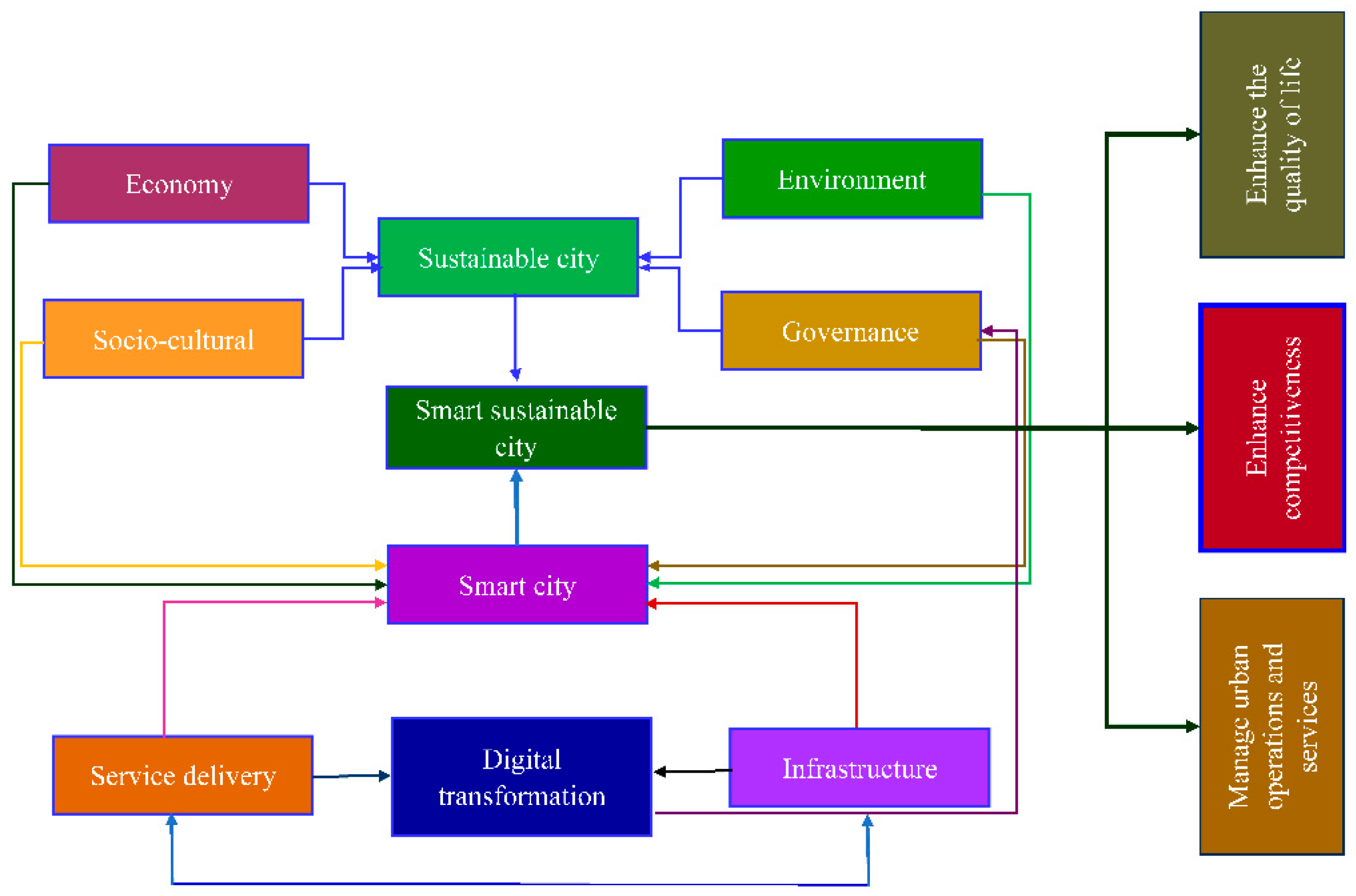
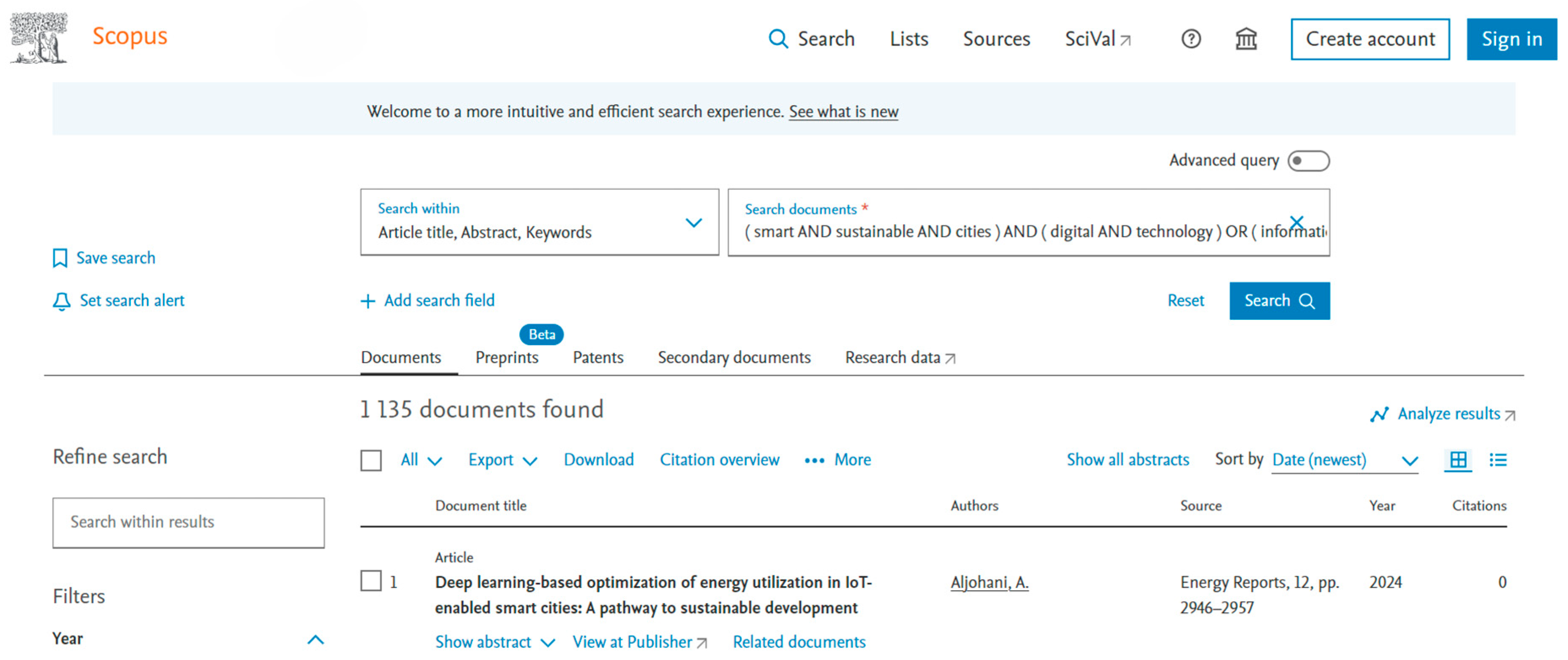
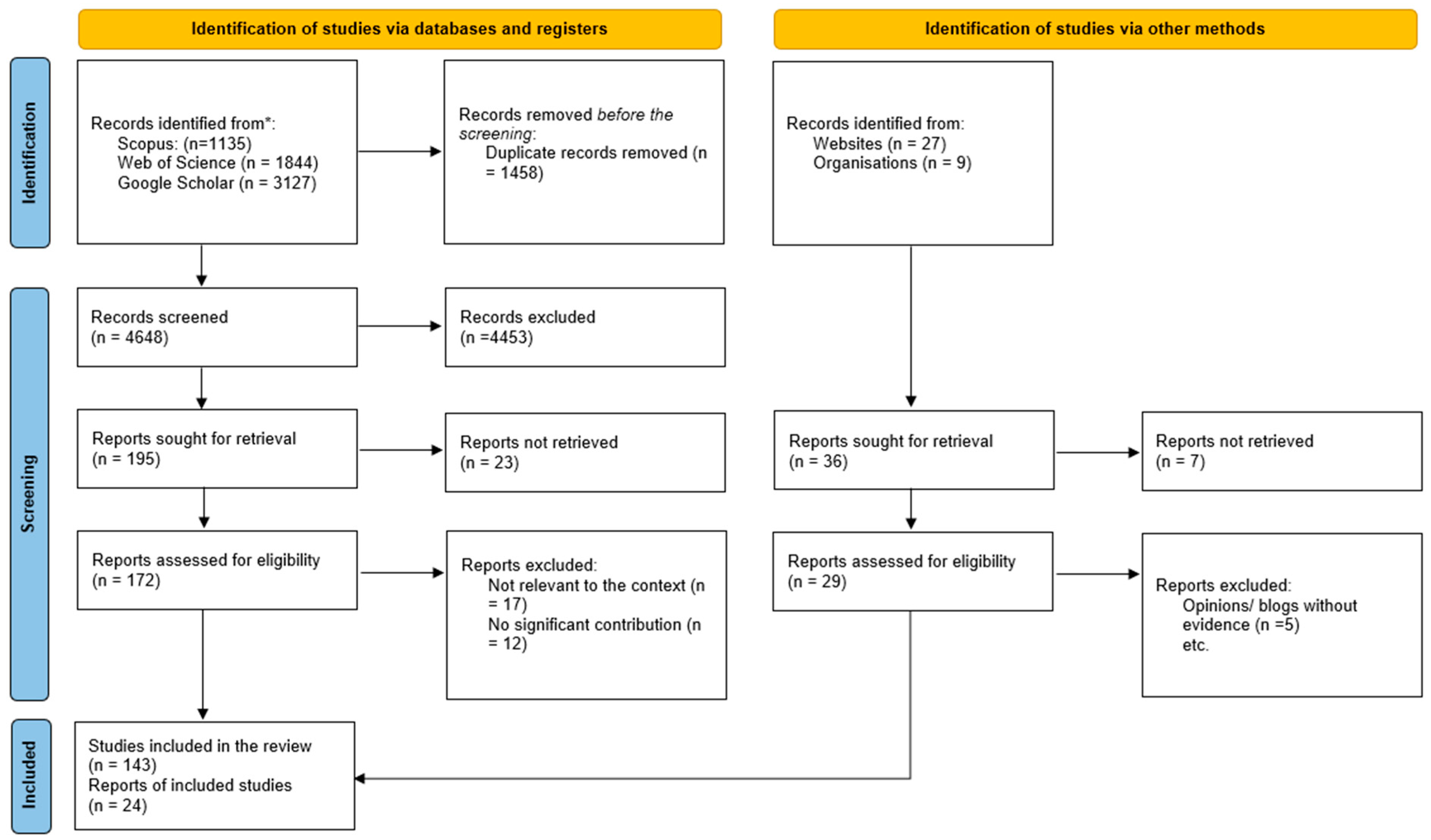
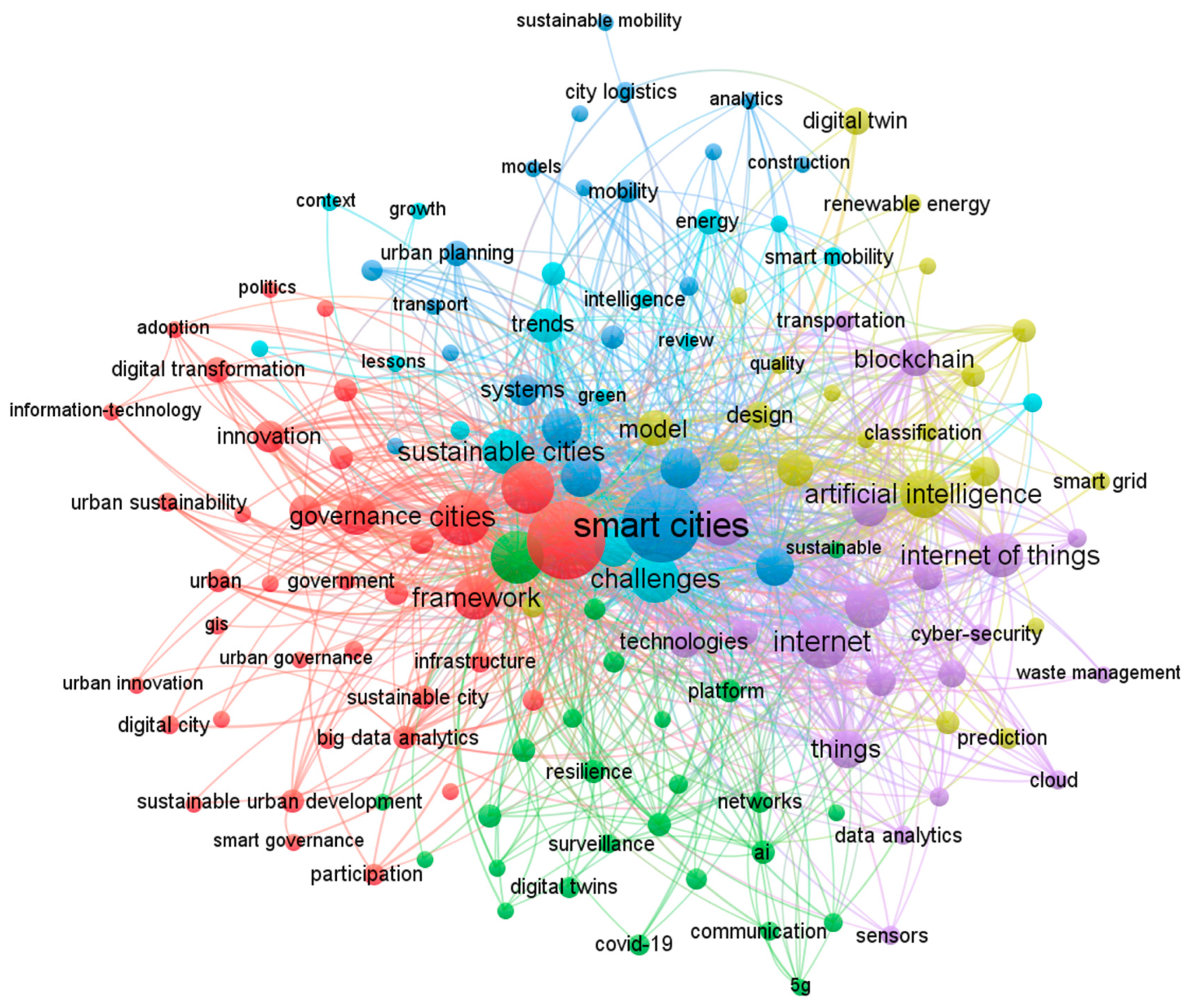
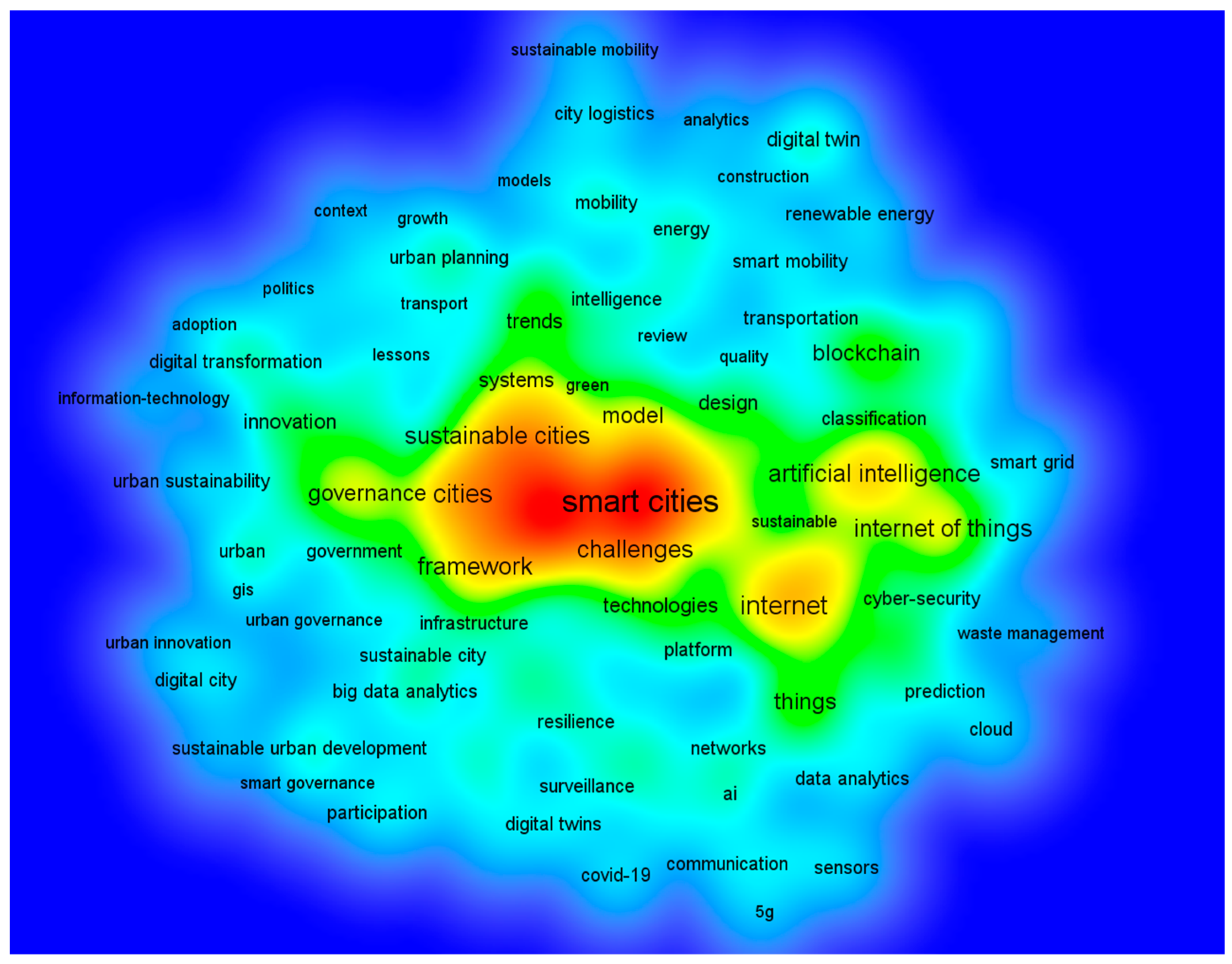

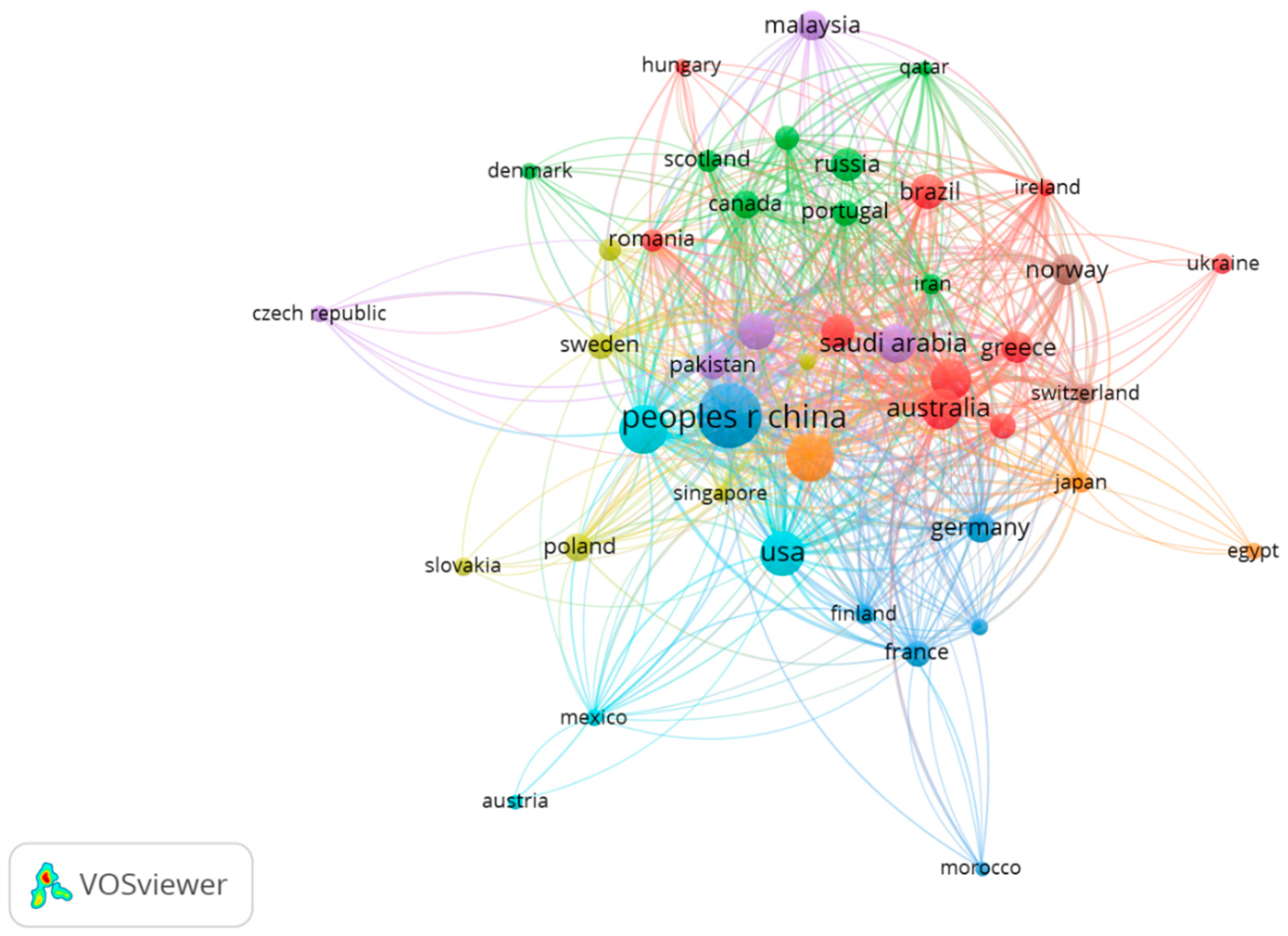
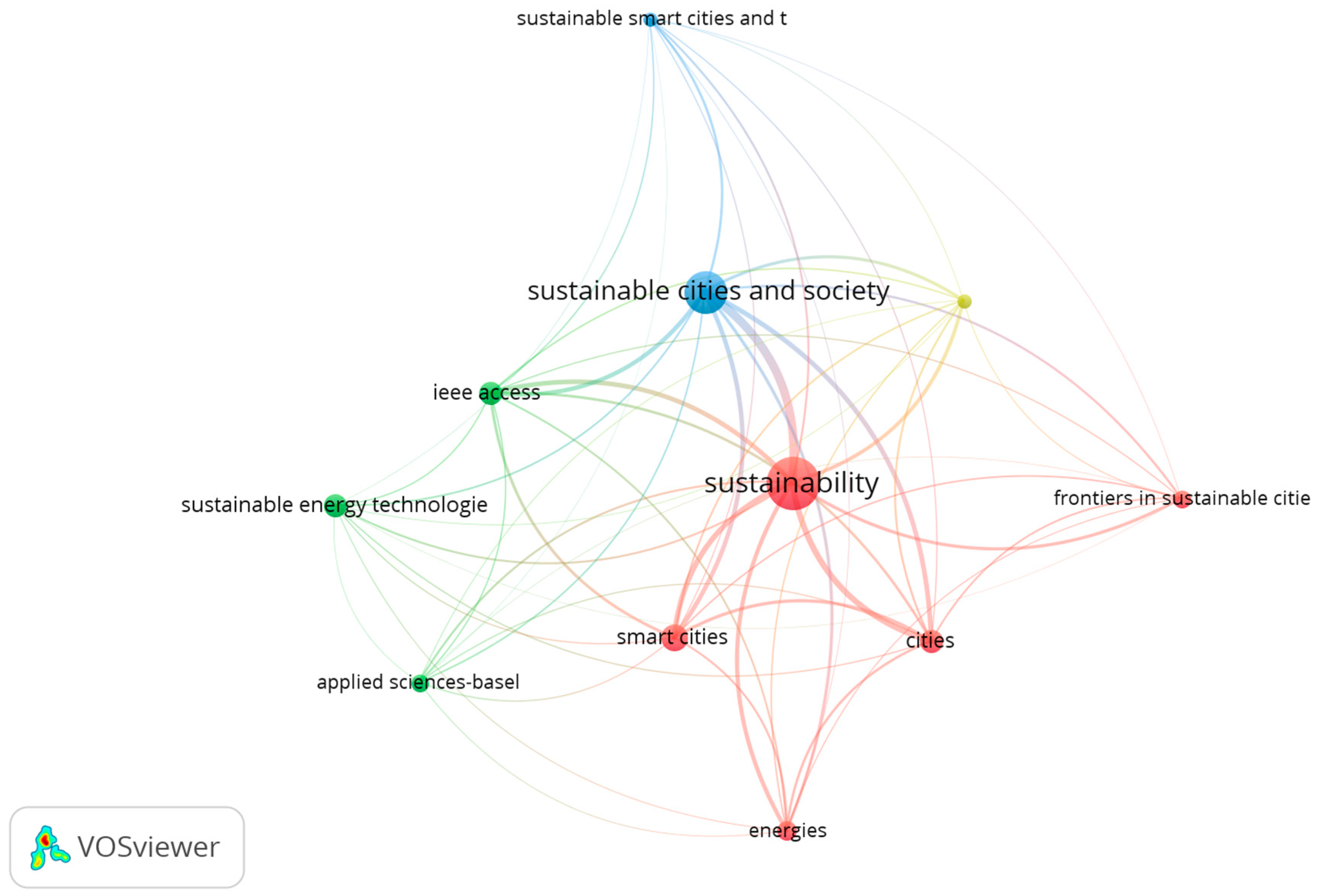

| Digital Technologies | Sources | AI Technologies | Sources |
|---|---|---|---|
| ICT | [57,58,59,60,61,62] | Machine Learning (ML) | [34,57,58,59,60,63] |
| IoT | Deep Learning (DL) | ||
| Big Data and Analytics | Natural Language Processing (NLP) | ||
| Smart Mobility Solutions | Computer Vision | ||
| Reinforcement Learning | |||
| Robotic Process Automation (RPA) |
| Urban Domains | Application Areas | Sources |
|---|---|---|
| Planning and management | Urban planning and management | [16,26,62,78] |
| Economy | Optimal resource utilisation and management | [18,21,23] |
| Knowledge economy | [79] | |
| Finance | [80] | |
| Enhance competitiveness | [21,23,79] | |
| Infrastructure and mobility | Transportation and mobility | [37,81,82,83] |
| Energy management | [84,85,86] | |
| Waste management | [5,30,52,87,88,89] | |
| Environment | Environmental monitoring | [90,91,92,93,94] |
| Reduction in emissions | [18] | |
| Governance | Governance, participation and responsiveness | [24,81,82,83,84,85,86] |
| Equity and inclusiveness | [24,95,96,97,98,99,100] | |
| People and living conditions | Quality of life | [13,22,23,101] |
| Health care | [13,22,23] | |
| Education | [13,22,23] |
| Database | Search String |
|---|---|
| Scopus | TITLE-ABS-KEY (Smart sustainable cities AND smart cities AND sustainable cities) AND (Digital Technology OR Information Communication Technology OR Internet of Things OR Big Data and Analytics OR Smart Mobility Solutions) OR (Artificial Intelligence OR (Machine Learning (ML) OR Deep Learning (DL) OR Natural Language Processing (NLP) OR Computer Vision OR Reinforcement Learning OR Robotic Process Automation (RPA)) AND (Potential AND Barriers) AND Strategies AND Global South |
| Inclusion | Exclusion |
|---|---|
| Peer-reviewed journals, books, book chapters, conference proceedings, and reports | Non-peer-reviewed journals |
| Empirical and conceptual papers | Review papers, patents, laws, meta-analyses, opinion articles, and debate articles |
| English language | Other languages than English |
| Smart cities, sustainable cities, and smart sustainable cities | Studies focusing on hardware and software of technology and AI |
| Digital technology, Information Communication Technology, Internet of Things, Artificial Intelligence, Machine Learning, Robotics, Deep Learning (DL), Natural Language Processing (NLP), Computer Vision, Reinforcement Learning, Robotic Process Automation (RPA) | Studies not focusing on smart, sustainable, and smart sustainable cities. |
| Global South, developing countries |
| Sl No. | Themes | Subthemes |
|---|---|---|
| 1 | Smart Sustainable Cities |
|
| 2 | Digital and AI technologies for driving Smart Sustainable Cities | |
| 3 | The Potential of Digital and AI Technologies in Smart, Sustainable Cities |
|
| 4 | Barriers to adoption and implementation |
|
| 5 | Specific applications of digital and AI technologies for smart sustainable cities in the Global South |
|
| 6 | Case Studies |
|
| Literature Source | Total (Numbers) | Share (%) | Global South (Number) | Share (%) |
|---|---|---|---|---|
| Journal | 113 | 67.66 | 57 | 39.86 |
| Books | 12 | 7.19 | ||
| Book chapters | 12 | 7.19 | ||
| Conference proceedings | 5 | 2.99 | ||
| Reports/web articles | 24 | 14.37 | 15 | 62.5 |
| Thesis | 1 | 0.60 | ||
| Total | 167 | 100.00 | 73 | 43.71 |
Disclaimer/Publisher’s Note: The statements, opinions and data contained in all publications are solely those of the individual author(s) and contributor(s) and not of MDPI and/or the editor(s). MDPI and/or the editor(s) disclaim responsibility for any injury to people or property resulting from any ideas, methods, instructions or products referred to in the content. |
© 2025 by the author. Licensee MDPI, Basel, Switzerland. This article is an open access article distributed under the terms and conditions of the Creative Commons Attribution (CC BY) license (https://creativecommons.org/licenses/by/4.0/).
Share and Cite
Das, D.K. Digital Technology and AI for Smart Sustainable Cities in the Global South: A Critical Review of Literature and Case Studies. Urban Sci. 2025, 9, 72. https://doi.org/10.3390/urbansci9030072
Das DK. Digital Technology and AI for Smart Sustainable Cities in the Global South: A Critical Review of Literature and Case Studies. Urban Science. 2025; 9(3):72. https://doi.org/10.3390/urbansci9030072
Chicago/Turabian StyleDas, Dillip Kumar. 2025. "Digital Technology and AI for Smart Sustainable Cities in the Global South: A Critical Review of Literature and Case Studies" Urban Science 9, no. 3: 72. https://doi.org/10.3390/urbansci9030072
APA StyleDas, D. K. (2025). Digital Technology and AI for Smart Sustainable Cities in the Global South: A Critical Review of Literature and Case Studies. Urban Science, 9(3), 72. https://doi.org/10.3390/urbansci9030072





